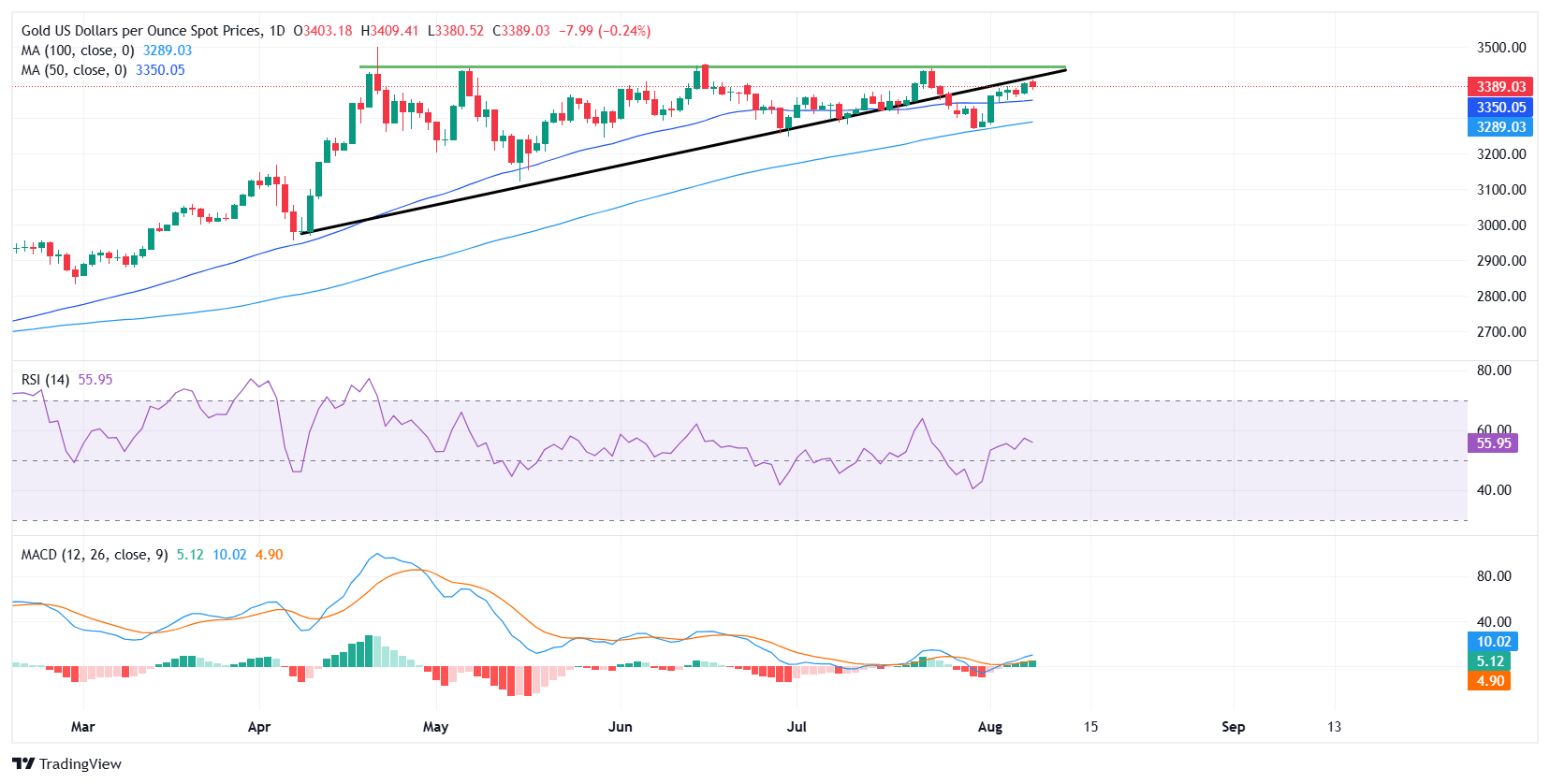Created
: 2025.08.08














![]() 2025.08.08 21:32
2025.08.08 21:32
Gold (XAU/USD) is edging lower on Friday after peaking at $3,409 earlier in the day, its highest level in two weeks amid a cautious market mood. At the time of writing, the metal is hovering near $3,395 at the start of the American session.
The precious metal remains underpinned by concerns over the economic impacts from US tariffs, persistent inflation worries, and growing speculation that the Federal Reserve (Fed) will lower the interest rate in September. However, a modest rebound in the US Dollar (USD) and relatively stable Treasury yields are capping further upside, as bulls struggle to decisively break above the key psychological barrier at $3,400.
While spot prices held steady with modest gains, Gold futures surged to fresh record highs after the Financial Times reported that the US has imposed new tariffs on 1-kg and 100-oz Gold bars. The December COMEX contract surged to an all-time high of $3,534.10 before paring gains slightly, fueled by concerns over potential supply chain disruptions and higher import costs. The bullish momentum spilled over into the Indian market as well, where MCX October Gold futures climbed to a new record above 1,02,000 INR per 10 grams, driven by a weak Indian Rupee, tariff-led supply risks, and robust investment demand.
As first reported by the FT, a ruling issued on July 31 by US Customs & Border Protection (CBP) now classifies one-kilogram and 100‑ounce Gold bars under the tariff code 7108.13.5500, bringing them under a higher import duty. These standard bullion bars are mainly refined in Switzerland. The move is expected to ramp up pressure on Switzerland, one of the world's largest precious metal hubs, which accounts for approximately $61.5 billion in annual Gold exports to the United States. It marks another blow for Switzerland, which is already facing a 39% tariff on a wide range of exports under the Trump administration's reciprocal trade measures.

Gold (XAU/USD) remains capped below the key $3,400 resistance as bears continue to defend the psychological barrier. After peaking at $3,409 -- a two-week high -- earlier on Friday, the metal struggled to sustain upward momentum. Price action continues to respect a broader ascending triangle formation, though the structure weakened slightly last week when Gold briefly broke below the rising trendline. That dip, however, found strong buying interest just above the 100-day Simple Moving Average (SMA) at $3,289, helping bulls regain footing and maintain the overall bullish structure.
The Relative Strength Index (RSI) on the daily chart sits at 55, hovering in neutral territory, suggesting neutral-to-mildly bullish momentum. Meanwhile, the Moving Average Convergence Divergence (MACD) indicator remains positive, with the MACD line holding above the signal line, hinting at improving momentum. However, the Average Directional Index (ADX) remains low, suggesting the current trend lacks strength.
For bulls to regain control, a daily close above the $3,400-$3,410 region is essential, which could open the door for a potential run toward $3,450, with all-time highs around $3,500 back on the radar. On the downside, key support lies at the 50-day SMA near $3,349, followed by the 100-day SMA at $3,289 -- a breakdown below which could invalidate the current bullish structure and shift bias in favor of the bears.
Gold has played a key role in human's history as it has been widely used as a store of value and medium of exchange. Currently, apart from its shine and usage for jewelry, the precious metal is widely seen as a safe-haven asset, meaning that it is considered a good investment during turbulent times. Gold is also widely seen as a hedge against inflation and against depreciating currencies as it doesn't rely on any specific issuer or government.
Central banks are the biggest Gold holders. In their aim to support their currencies in turbulent times, central banks tend to diversify their reserves and buy Gold to improve the perceived strength of the economy and the currency. High Gold reserves can be a source of trust for a country's solvency. Central banks added 1,136 tonnes of Gold worth around $70 billion to their reserves in 2022, according to data from the World Gold Council. This is the highest yearly purchase since records began. Central banks from emerging economies such as China, India and Turkey are quickly increasing their Gold reserves.
Gold has an inverse correlation with the US Dollar and US Treasuries, which are both major reserve and safe-haven assets. When the Dollar depreciates, Gold tends to rise, enabling investors and central banks to diversify their assets in turbulent times. Gold is also inversely correlated with risk assets. A rally in the stock market tends to weaken Gold price, while sell-offs in riskier markets tend to favor the precious metal.
The price can move due to a wide range of factors. Geopolitical instability or fears of a deep recession can quickly make Gold price escalate due to its safe-haven status. As a yield-less asset, Gold tends to rise with lower interest rates, while higher cost of money usually weighs down on the yellow metal. Still, most moves depend on how the US Dollar (USD) behaves as the asset is priced in dollars (XAU/USD). A strong Dollar tends to keep the price of Gold controlled, whereas a weaker Dollar is likely to push Gold prices up.
![]()
Created
: 2025.08.08
![]()
Last updated
: 2025.08.08

FXStreet is a forex information website, delivering market analysis and news articles 24/7.
It features a number of articles contributed by well-known analysts, in addition to the ones by its editorial team.
Founded in 2000 by Francesc Riverola, a Spanish economist, it has grown to become a world-renowned information website.
We hope you find this article useful. Any comments or suggestions will be greatly appreciated.
We are also looking for writers with extensive experience in forex and crypto to join us.
please contact us at [email protected].
Disclaimer:
All information and content provided on this website is provided for informational purposes only and is not intended to solicit any investment. Although all efforts are made in order to ensure that the information is correct, no guarantee is provided for the accuracy of any content on this website. Any decision made shall be the responsibility of the investor and Myforex does not take any responsibility whatsoever regarding the use of any information provided herein.
The content provided on this website belongs to Myforex and, where stated, the relevant licensors. All rights are reserved by Myforex and the relevant licensors, and no content of this website, whether in full or in part, shall be copied or displayed elsewhere without the explicit written permission of the relevant copyright holder. If you wish to use any part of the content provided on this website, please ensure that you contact Myforex.
Myforex uses cookies to improve the convenience and functionality of this website. This website may include cookies not only by us but also by third parties (advertisers, log analysts, etc.) for the purpose of tracking the activities of users. Cookie policy